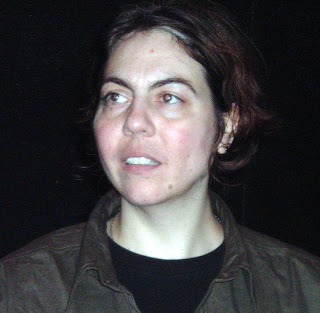

Jim Brashear, on hiatus from New York for a week & I (not masked) attended Small Press Traffic's offering of Craig Santos Perez and Stacy Szymaszek reading from their work on Friday the 13th. 
Craig Santos Perez was up first and read from new work. He offered us his version of an inauguration day poem. I can't remember if "Senator Kennedy we love you get up" is the title or if this is a line from within the poem itself. But there it is.
Craig offered us villanelles, haiku and other work. His haiku were part of a series or a poem in sections entitled "All with Ocean Views" which explored, in part, the construction of Guam as a tourist destination and site of U.S. military bases. Both Chamoru culture and the resources of the island itself have been devastated from colonization, war and occupation.
In his statement to the U.N. in 2008, copies of which Craig offered us, he writes:
During and immediately after World War II, brown tree snakes invaded Guam as stowaways on U.S. naval cargo ships. By 1968, the snakes colonized the entire island, their population reaching a density of 13,000 per square mile. As a result, Guam's seabirds, 10 of 13 endemic species of forest birds, 2 of 3 native mammals, and 6 of 10 native species of lizards have all gone extinct.
The U.S. plans to introduce--this time intentionally--a more familiar breed of predators to Guam: an estimated 19,000 military personnel and 20,000 of their dependents, along with numerous overseas businesses and 20,000 contract workers to support the military build-up. Add this to the 14,000 military personnel already on Guam, and that's a combined total of 73,000--outnumbering the entire Chamoru population on Guam, which is roughly 62,900.
Perez's poetry explores this history. One of his poems from his second book featured the recurring line "sheet water," and then a Chamorro phrase that I can't reproduce here. I also jotted down, "let there be no
beginning to what this can bear."
It is a pleasure to listen to Craig read. Here is a review by Jake Kennedy of Santos Perez's Unincorporated Territory.
And here's Craig's bio from SPT:
Craig Santos Perez, a native Chamoru from the Pacific Island of Guahan (Guam), is a co-founder of Achiote Press and author of from unincorporated territory [hacha] (Tinfish Press, 2008). His poetry, essays, reviews, and translations have appeared (or are forthcoming) in New American Writing, Pleiades, The Denver Quarterly, The Colorado Review, and ZYZZYVA, among others.
Next up was Stacy Szymaszek. I wasn't familiar with Stacy's work, though there is no excuse for that. I was happy to have the opportunity to hear her read and I brought home with me a copy of her chapbook, Orizaba: A Voyage with Hart Crane. It was pricey, 10 bucks, but worth it. Cynthia Sailers provided a smart introduction to Stacy's work, explaining its queer,perverse trajectory. Loved it!
Here's a tiny tidbit of what Stacy read from Orizaba:
"In all the argosy of your bright hair I dreamed
Nothing so flagless as this piracy."--HC
My interest in Hart Crane began as purely physical. I saw a picture of him when I was a young boy that gave my confused desires a focus. He was wearing a Marseilles sailor suite, leaning against a tree in Mexico with a dark-haired woman named Peggy Cowley. None of this mattered at the time. It was his hair, which was cropped close on the sides and combed up in front. I acquired this hairstyle slowly, each cut coming closer to resemblance. In my mind, something forbidden was happening. When I asked my mother to buy me striped shirts from the mall, she seemed pleased that I was showing any interest in fashion. Not knowing what else to do, I copied what I liked about him. It is remarkable that a hart Crane biography ever made it to our little public library. Voyager was being discharged and sold for a dime. Its 831 pages, including the index, was written by a man named John Unterecker and published by Liveright, the same press that issued the trade edition of Crane's magnum opus The Bridge. A previous reader had underlined a sentence on page 656, "Then in front of Orizaba everything suddenly begins to change." Hart Crane had originally written this on a postcard.
With this piece, Stacy left us in medias res and wanting more.
From one of her poems, I jotted down:
she localizes words
forms fibroblasts
uses a fibroblaster
There is something precise and sleeper wave-like about Szymaszeck's poetry. It rolls up and suddenly knocks you down.
Read a review of Stacy's Some Mariners by Jake Kennedy here.
Check out the work of these writers both.
Here's Stacy's bio, again, from Small Press Traffic:
Stacy Szymaszek is the author of Emptied of All Ships (Litmus, 2005) as well as many chapbooks, most recently Orizaba: A Voyage With Hart Crane (Faux, 2008), and from Hyperglossia (Hot Whiskey, 2008). Stacy S: Autoportraits which features her self-portraits with texts written in response by Lisa Jarnot, Renee Gladman, Kevin Killian and others was also published in 2008 by OMG!. The complete Hyperglossia will be published by Litmus Press in spring of 2009. She is the editor of Gam and the Artistic Director of the Poetry Project at St. Mark's Church.
No comments:
Post a Comment